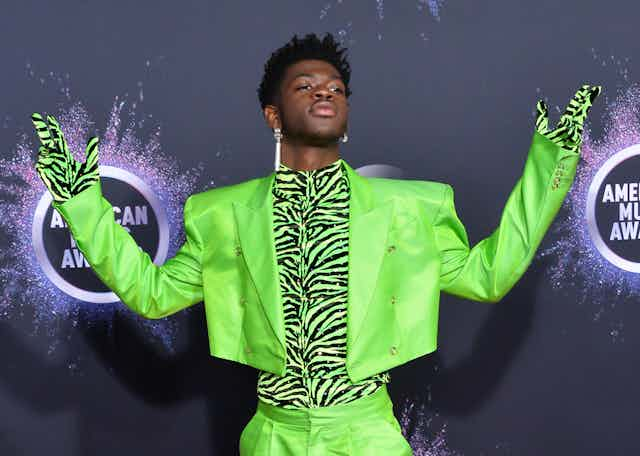Although camp is difficult to define, it probably doesn’t need much description.
Ever since 1956 – when former teenage drag queen Little Richard began performing his tribute to anal sex, “Tutti Frutti”, while wearing a six-inch pompadour, plucked eyebrows, and eyeliner – camp has increasingly been accommodated into social acceptance and understanding. It has been adopted and adapted by celebrities including Dolly Parton, Prince, Elton John, Ru Paul, Lady Gaga, and Lil Nas X. It was the theme of the 2019 Met Gala, prompting widespread commentary about what camp is.
Susan Sontag, whose work inspired the Met Gala Ball’s theme, wrote in Notes on Camp (1964) that camp is about “artifice and the unnatural”, a “way of seeing the world as an aesthetic phenomenon”. Camp, Sontag continues, is “the spirit of extravagance”, as well as “a kind of love, a love for human nature”, which “relishes, rather than judges”.
Sontag also writes, however, that the camp sensibility is “disengaged, depoliticized”, and that it emphasises the “decorative … at the expense of content”. But camp is intricately enmeshed with queerness, and is anything but disengaged and merely decorative. Rather, in subverting social norms and rejecting easy categorisation, it has a long and radical history.
Camp’s political beginnings
For many working class queer men in urban centres such as New York around the turn of the 20th century, camp was a tactic for the communication and affirmation of non-normative sexualities and genders. This was enacted at Coney Island male beauty contests, Harlem and Midtown drag balls, and in the streets and saloons of downtown Manhattan.

As historian George Chauncey established in his book Gay New York, the so-called “fairy resorts” (nightclubs whose attraction was the presence of effeminate men), which sprang up downtown, established the dominant public image of queer male sexuality. This was defined by a cultivated or performed effeminacy, including make-up, falsetto, and the use of “camp names” and female pronouns.
These men questioned gender categories, and did so by behaving “camply”. In this way, camp evolved as a visible queer signifier. It has helped some queer people, both then and since, “make sense of, respond to, and undermine”, in Chauncey’s words, “the social categories of gender and sexuality that serve to marginalise them”.

Decades later, in late June 1969, not far from New York’s former “fairy resorts”, a group of queer and trans teenagers used camp to dramatically shift the outcome of the Stonewall uprising. A series of demonstrations against the closure of a popular gay bar, these protests are often credited with launching the gay rights movement.
Facing an elite unit of armed police, the youths marshalled their campest street repertoire, joining arms, kicking their legs in the air like a precision dance troupe. They sang “We are the Stonewall Girls / We wear our hair in curls,” and called the police “Lily Law” and “the girls in blue”. Once again, camp accomplished a powerful subversion, this time of the presumed machismo and authority of the police.
Liking camp
Camp offers a critical stance that derives from the experience of being labelled deviant, highlighting the artificiality of social conventions. For the writer Christopher Isherwood, whose 1939 novel Goodbye to Berlin became the darkly camp musical Cabaret (1966), camp was underpinned by “seriousness”. To deploy it was to express “what’s basically serious to you in terms of fun and artifice and elegance”.
Two of the 20th century’s campest artists, Andy Warhol and Joe Brainard, took Isherwood’s stance on camp seriously, and based much of their careers on the belief that “liking” was a valuable aesthetic. Both are famous for the camp excess of their imagery, producing work that featured multiple iterations of camp images.
For Warhol, it was Marilyn Monroes and Jackie Kennedys. For Brainard, pansies and Madonnas. Even, in Brainard’s case, a transgressive, dramatic account of how much he liked Warhol , featuring the words “I like Andy Warhol” repeated 14 times. Warhol also embraced camp as a personal style, performing a theatrical effeminacy that equated to a strategic queerness designed to discomfit those among his contemporaries who held him to be “too swish”.
Warhol’s use of camp finds an echo, in the 21st century, in the work of Lil Nas X, a musical artist who similarly deploys Sontag’s iteration of camp as “a mode of seduction — one which employs flamboyant mannerisms susceptible of a double interpretation”.
His smash hit “Old Town Road” (2019) is a queer country/hip-hop cross-over, whose music video is replete with sequins, tassels, chaps and choreographed dancing. Much of this was ignored by some fans who only appeared to notice Lil Nas X’s commitment to camp on the release of the video for “Montero (Call Me By Your Name)” (2021).
Montero features the biblical Adam making out with the serpent in the Garden of Eden, before gleefully riding down a stripper pole to hell where he performs a lapdance for Satan (all characters played by Lil Nas X). Like Warhol, Lil Nas X uses a camp style to put visuals to repressive narratives and double standards.
In particular, he claims camp transgression for black queerness, enacting, once again, a critical stance on the contradictions and condemnations that serve to marginalise those who don’t, or can’t, conform. His work confirms, in other words, that camp is much more than a quirky outfit. That it is a strategy, as much as a style.

